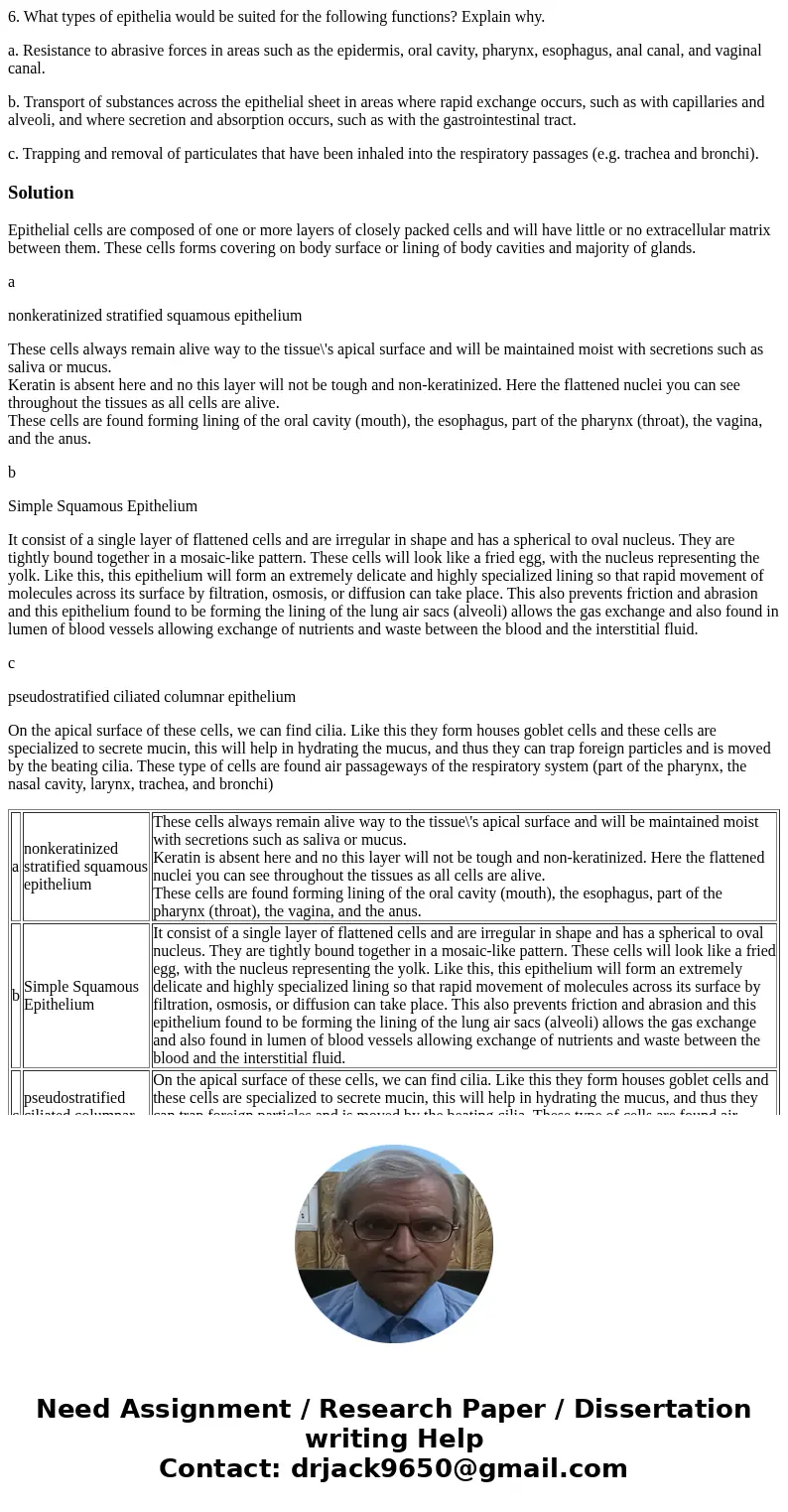6 What types of epithelia would be suited for the following
6. What types of epithelia would be suited for the following functions? Explain why.
a. Resistance to abrasive forces in areas such as the epidermis, oral cavity, pharynx, esophagus, anal canal, and vaginal canal.
b. Transport of substances across the epithelial sheet in areas where rapid exchange occurs, such as with capillaries and alveoli, and where secretion and absorption occurs, such as with the gastrointestinal tract.
c. Trapping and removal of particulates that have been inhaled into the respiratory passages (e.g. trachea and bronchi).
Solution
Epithelial cells are composed of one or more layers of closely packed cells and will have little or no extracellular matrix between them. These cells forms covering on body surface or lining of body cavities and majority of glands.
a
nonkeratinized stratified squamous epithelium
These cells always remain alive way to the tissue\'s apical surface and will be maintained moist with secretions such as saliva or mucus.
Keratin is absent here and no this layer will not be tough and non-keratinized. Here the flattened nuclei you can see throughout the tissues as all cells are alive.
These cells are found forming lining of the oral cavity (mouth), the esophagus, part of the pharynx (throat), the vagina, and the anus.
b
Simple Squamous Epithelium
It consist of a single layer of flattened cells and are irregular in shape and has a spherical to oval nucleus. They are tightly bound together in a mosaic-like pattern. These cells will look like a fried egg, with the nucleus representing the yolk. Like this, this epithelium will form an extremely delicate and highly specialized lining so that rapid movement of molecules across its surface by filtration, osmosis, or diffusion can take place. This also prevents friction and abrasion and this epithelium found to be forming the lining of the lung air sacs (alveoli) allows the gas exchange and also found in lumen of blood vessels allowing exchange of nutrients and waste between the blood and the interstitial fluid.
c
pseudostratified ciliated columnar epithelium
On the apical surface of these cells, we can find cilia. Like this they form houses goblet cells and these cells are specialized to secrete mucin, this will help in hydrating the mucus, and thus they can trap foreign particles and is moved by the beating cilia. These type of cells are found air passageways of the respiratory system (part of the pharynx, the nasal cavity, larynx, trachea, and bronchi)
| a | nonkeratinized stratified squamous epithelium | These cells always remain alive way to the tissue\'s apical surface and will be maintained moist with secretions such as saliva or mucus. |
| b | Simple Squamous Epithelium | It consist of a single layer of flattened cells and are irregular in shape and has a spherical to oval nucleus. They are tightly bound together in a mosaic-like pattern. These cells will look like a fried egg, with the nucleus representing the yolk. Like this, this epithelium will form an extremely delicate and highly specialized lining so that rapid movement of molecules across its surface by filtration, osmosis, or diffusion can take place. This also prevents friction and abrasion and this epithelium found to be forming the lining of the lung air sacs (alveoli) allows the gas exchange and also found in lumen of blood vessels allowing exchange of nutrients and waste between the blood and the interstitial fluid. |
| c | pseudostratified ciliated columnar epithelium | On the apical surface of these cells, we can find cilia. Like this they form houses goblet cells and these cells are specialized to secrete mucin, this will help in hydrating the mucus, and thus they can trap foreign particles and is moved by the beating cilia. These type of cells are found air passageways of the respiratory system (part of the pharynx, the nasal cavity, larynx, trachea, and bronchi) |

 Homework Sourse
Homework Sourse